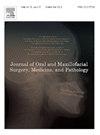基于水平和垂直位置分类的上颌前阻生多生牙临床研究
IF 0.4
Q4 DENTISTRY, ORAL SURGERY & MEDICINE
Journal of Oral and Maxillofacial Surgery Medicine and Pathology
Pub Date : 2024-12-06
DOI:10.1016/j.ajoms.2024.12.006
引用次数: 0
摘要
目的探讨上颌前阻生多生牙(AMIST)的拔除手术入路与中牙阻生多生牙(AMIST)尺寸位置的关系。方法本回顾性研究纳入了需要计算机断层扫描进行拔牙的AMIST患者。分析AMIST患者的牙数、嵌塞方向、手术年龄、手术时间及手术入路。AMIST分为两组(H:水平位,V:垂直位);每组分为若干亚组(H1、2、3;结果共纳入AMIST 223例。根据嵌塞的方向,142颗牙分为倒立型,正常型69颗,水平型12颗。竖直位置越高,H2区(恒中切牙腭侧与切管之间的区域)的手术年龄和手术时间明显增加。H2区<; 7岁比≥ 10岁、≥ 7岁、<; 8岁比≥ 10岁手术时间明显增加。腭入路最多(214颗,96.0 %),其次是唇入路(8颗,3.6 %)和鼻底入路(1颗,0.4 %)。结论计算机断层图像对水平和垂直体位的分类对术前治疗计划至关重要,有助于外科医生确定手术入路方法,评估手术难度和侵犯程度。本文章由计算机程序翻译,如有差异,请以英文原文为准。
A clinical study of anterior maxillary impacted supernumerary teeth based on the classification of horizontal and vertical positions
Objective
This study aimed to reveal the relationship between the surgical approach of extraction and the dimensional position of the anterior maxillary impacted supernumerary teeth (AMIST), impacted mesiodens according to the definition of the systematized classification of horizontal and vertical position.
Methods
This retrospective study included patients with AMIST who required computed tomography for extraction. The number of teeth, direction of impaction, age at the surgery, operative time, and surgical approach for AMIST were analyzed. AMIST was classified into two groups (H: horizontal position and V: vertical position); each group was divided into several subgroups (H1, 2, 3; V1, 2, 3, 4).
Results
In total, 223 AMIST were included. Based on the direction of impaction, 142 teeth were categorized as inverted, 69 normal, and 12 horizontal. With vertically higher positions, age at the operation and operative time were considerably increased in the H2 region (the area between the palatal side of the permanent central incisor and the incisive canal). The operative time was markedly increased in < 7 years old versus ≥ 10 years old and ≥ 7 years old and < 8 years old versus ≥ 10 years old in the H2 region. The palatal approach was the most common (214 teeth, 96.0 %), followed by the labial (8 teeth, 3.6 %) and nasal floor (1 tooth, 0.4 %) approaches.
Conclusions
Classifying of horizontal and vertical positions by computed tomography images is crucial in preoperative treatment planning since it helps surgeons decide on the surgical approach methods and evaluate surgical difficulty and invasion.
求助全文
通过发布文献求助,成功后即可免费获取论文全文。
去求助
来源期刊

Journal of Oral and Maxillofacial Surgery Medicine and Pathology
DENTISTRY, ORAL SURGERY & MEDICINE-
CiteScore
0.80
自引率
0.00%
发文量
129
审稿时长
83 days
 求助内容:
求助内容: 应助结果提醒方式:
应助结果提醒方式:


